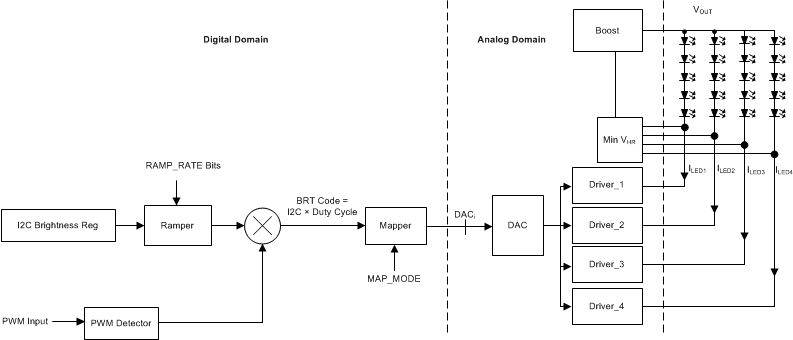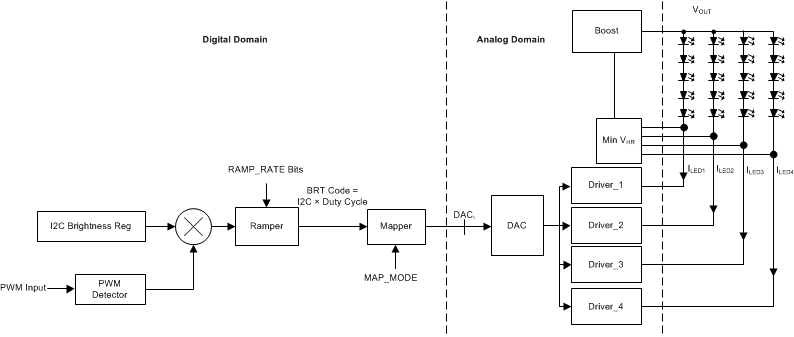ZHCSGN9D February 2016 – March 2018 LM36274
PRODUCTION DATA.
- 1 特性
- 2 应用
- 3 说明
- 4 修订历史记录
- 5 Pin Configuration and Functions
- 6 Specifications
-
7 Detailed Description
- 7.1 Overview
- 7.2 Functional Block Diagram
- 7.3
Features Description
- 7.3.1 Enabling the LM36274
- 7.3.2 Backlight
- 7.3.3 LCM Bias
- 7.3.4 Software Reset
- 7.3.5 HWEN Input
- 7.3.6 Thermal Shutdown (TSD)
- 7.4 Device Functional Modes
- 7.5 Programming
- 7.6
Register Maps
- 7.6.1 Revision Register (Address = 0x01)[Reset = 0x01]
- 7.6.2 Backlight Configuration1 Register (Address = 0x02)[Reset = 0x28]
- 7.6.3 Backlight Configuration 2 Register (Address = 0x03)[Reset = 0x8D]
- 7.6.4 Backlight Brightness LSB Register (Address = 0x04)[Reset = 0x07]
- 7.6.5 Backlight Brightness MSB Register (Address = 0x05)[Reset = 0xFF]
- 7.6.6 Backlight Auto-Frequency Low Threshold Register (Address = 0x06)[Reset = 0x00]
- 7.6.7 Backlight Auto-Frequency High Threshold Register (Address = 0x07)[Reset = 0x00]
- 7.6.8 Backlight Enable Register (Address = 0x08)[Reset = 0x00]
- 7.6.9 Bias Configuration 1 Register (Address = 0x09)[Reset = 0x18]
- 7.6.10 Bias Configuration 2 register (Address = 0x0A)[Reset = 0x11]
- 7.6.11 Bias Configuration 3 Register (Address = 0x0B)[Reset = 0x00]
- 7.6.12 LCM Boost Bias Register (Address = 0x0C)[Reset = 0x28]
- 7.6.13 VPOS Bias Register (Address = 0x0D)[Reset = 0x1E]
- 7.6.14 VNEG Bias Register (Address = 0x0E)[Reset = 0x1C]
- 7.6.15 Flags Register (Address = 0x0F)[Reset = 0x00]
- 7.6.16 Option 1 Register (Address = 0x10)[Reset = 0x06]
- 7.6.17 Option 2 Register (Address = 0x11)[Reset = 0x35]
- 7.6.18 PWM-to-Digital Code Readback LSB Register (Address = 0x12)[Reset = 0x00]
- 7.6.19 PWM-to-Digital Code Readback MSB Register (Address = 0x13)[Reset = 0x00]
- 8 Application and Implementation
- 9 Power Supply Recommendations
- 10Layout
- 11器件和文档支持
- 12机械、封装和可订购信息
7.3.2.3.2.1 PWM Ramper
The PWM ramp option (register 0x02 bit[1]) determines whether the ramper is active or inactive during a change in PWM duty cycle.
The ramper smooths the transition from one brightness value to another. Ramp time can be adjusted from 0 ms to 8000 ms with LED Current Ramp [3:0] bits (register 0x03 bits [6:3]). Ramp time is used for sloping both up and down. Ramp time always remains the same regardless of the amount of change in brightness.
In PWM mode the behavior of the ramper depends on the state of the PWM Ramp bit (register 0x02, bit [1]). If the PWM Ramp bit is set to 0, there is no LED current ramping between PWM duty cycle changes. The PWM duty cycle is multiplied with the I2C brightness code at the output of the ramper (see Figure 35). If this bit is set to 1, ramping is achieved between I2C × PWM currents (see Figure 36).
 Figure 35. (I2C + PWM) Brightness Control, PWM Ramper Disabled
Figure 35. (I2C + PWM) Brightness Control, PWM Ramper Disabled
 Figure 36. (I2C + PWM) Brightness Control, PWM Ramper Enabled
Figure 36. (I2C + PWM) Brightness Control, PWM Ramper Enabled